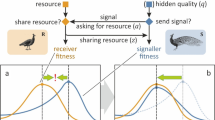Abstract
Communication and social behaviour are inextricably linked, with communication mediating important social behaviours such as resource defence and mate attraction. However, the social environment in which communication occurs is often ignored in discussions of communication behaviour. We argue that networks of several individuals are the common social environment for communication behaviour. The consequences for receivers and signallers of communicating in a network environment are the main subjects of this review. Eavesdropping is a receiving behaviour that is only possible in the environment of a network and therefore we concentrate on this behaviour. The main effect of communication networks on signallers is to create competition with other signallers for receiver attention. We discuss the consequences of such competition. To conclude, we explore the role of signals and signalling interactions as sources of information that animals exploit to direct their behaviour.
Similar content being viewed by others
Author information
Authors and Affiliations
Additional information
Received: 1 December 1999 / Received in revised form: 18 January 2000 / Accepted: 18 January 2000
Rights and permissions
About this article
Cite this article
McGregor, P., Peake, T. Communication networks: social environments for receiving and signalling behaviour. acta ethol 2, 71–81 (2000). https://doi.org/10.1007/s102110000015
Issue Date:
DOI: https://doi.org/10.1007/s102110000015




